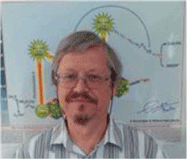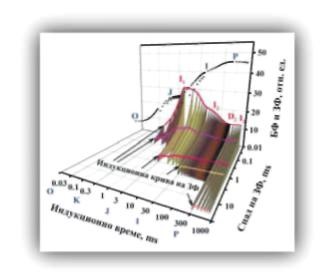Name of Excellence: Biophysical Phenotyping of Plants
Author: Prof. Vasilij Goltsev, PhD, Department of Biophysics and Radiobiology
Research domain: Biology, Biophysics of Photosynthesis
|
| Prof. Vasilij Goltsev, PhD was born in 1950 in Russia. He graduated MS and PhD at Moscow State University, Faculty of Biology, Department of Biophysics. He has been a Lecturer at the Department of Biophysics and Radiobiology of the Faculty of Biology, Sofia University since 1980 and he was heading this department in the periods 1991–2004 and 2008–2012. Expert in biophysics of photosynthesis, fluorescent methods for analysis of the photosynthesis, and stress reactions in plants.
| |
| Prof. Vasilij Goltsev, PhD |
A biophysical approach for multi parametric estimation of the physiological state and stress reaction in plants at in vivo and in situ conditions has been developed.
The approach is based on measuring and analysis of luminescent and optical signals emitted from the leaf surface. The most efficient way to receive information from plant living tissues about photosynthetic reactions is an analysis of light induced transients of prompt and delayed chlorophyll fluorescence (see the Figure).
They provide information about quantum efficiency and electron transport rate in different sites of the photosynthetic electron transport chain, as well as about the collection and redistribution of light energy in the photo system II antenna complexes. For prompt fluorescence signal analysis the approach known as JIP-test was used. To link data from induction curves of prompt and delayed chlorophyll a fluorescence and of 820 nm light reflection with general physiological characteristics of plants an approach was developed. It is based on the artificial neural networks, which are capable to recognize the taxonomic classification of the plant or the level of water stress in the leaves with high level of confidence.
Since the method is non-invasive and highly informative, it has become a powerful tool for photosynthetic researches at in vivo conditions and it is perspective for environmental monitoring of plant ecosystems. It allows to link genotype (taxonomical and functional) characteristics of the plant samples to their phenotype, expressed by the values of a group of experimental parameters as a kind of “barcode” that uniquely represents the functional state of the investigated plant species.
The study was financed by the Bulgarian Science Fund within the framework of a research project (№ 02-137/ 15.12.2008).
The study was carried out in scientific cooperation with Bulgarian (Institute of Plant Physiology and Genetics, BAS, Sofia; Agricultural University, Plovdiv) and foreign scientific organizations (Bioenergetics Laboratory, University of Geneva, Switzerland; Department of Plant Physiology, Warsaw University of Life Sciences SGGW, Poland; Freie Universität Berlin, Germany; Institute of Plant Physiology, Russian Academy of Sciences, Moscow, Russia; Institute of Basic Biological Problems, Russian Academy of Sciences, Pushchino, Moscow Region, Russia; Moscow State University, M.V. Lomonosov, Faculty of Biology, Department Biophysics, Moscow, Russia; Department of Biochemistry, Department of Plant Biology, and Center of Biophysics and Computational Biology, University of Illinois at Urbana-Champaign, Urbana, IL, USA)




